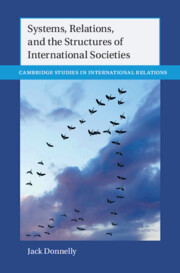Book contents
- Systems, Relations, and the Structures of International Societies
- Cambridge Studies in International Relations
- Systems, Relations, and the Structures of International Societies
- Copyright page
- Contents
- Figures
- Tables
- Acknowledgments
- Part I Systems, Relations, Levels, and Explanations
- Part II Waltzian Structural Theory
- Part III Systems, Relations, and Processes
- References
- Index
- Cambridge Studies in International Relations
12 - Continuous (Trans)formation
Producing Social Continuity and Social Change
from Part III (A) - Differentiation and Continuous (Trans)Formation
Published online by Cambridge University Press: 19 October 2023
- Systems, Relations, and the Structures of International Societies
- Cambridge Studies in International Relations
- Systems, Relations, and the Structures of International Societies
- Copyright page
- Contents
- Figures
- Tables
- Acknowledgments
- Part I Systems, Relations, Levels, and Explanations
- Part II Waltzian Structural Theory
- Part III Systems, Relations, and Processes
- References
- Index
- Cambridge Studies in International Relations
Summary
In a world of pre-given substances (or static relations) change needs to be explained. In a processual world, though, change, not stasis, is the norm. Persistence therefore demands explanation. Living and social systems are far-from-thermodynamic-equilibrium systems that, by taking in and creatively utilizing matter or energy, temporarily stave off the inexorable physical progression of entropy (movement towards greater disorder; decay). Social continuities no less than social transformations are socially produced. (A state, for example, can be kept in the far-from-thermodynamic-equilibrium state of statehood only through extensive and complex processes of (re)production.) And both continuities and transformations arise from similar processes that operate continuously. The chapter illustrates what I call continuous (trans)formation with the case of the development of modern militaries and introduces both John Padgett and Walter Powell’s framing of transposition and re-functionality and William Sewell’s framing of eventful history.
Keywords
Information
- Type
- Chapter
- Information
- Publisher: Cambridge University PressPrint publication year: 2023
